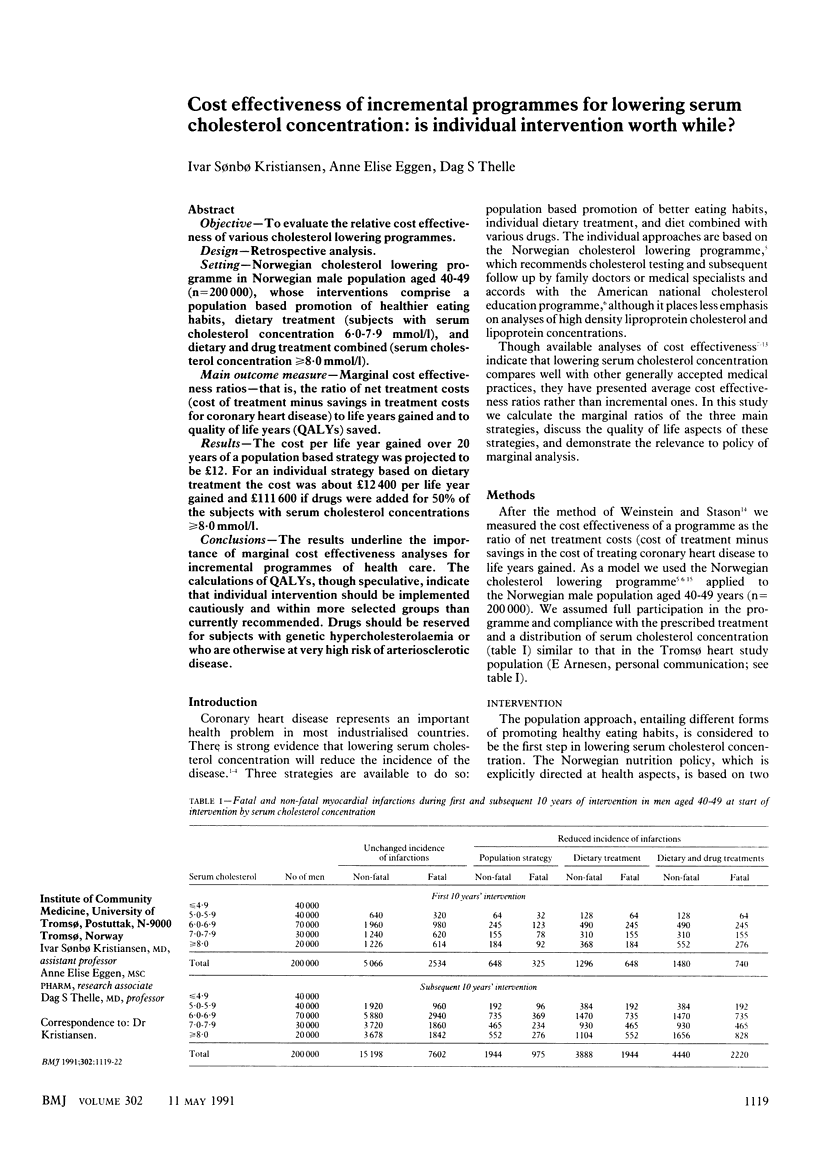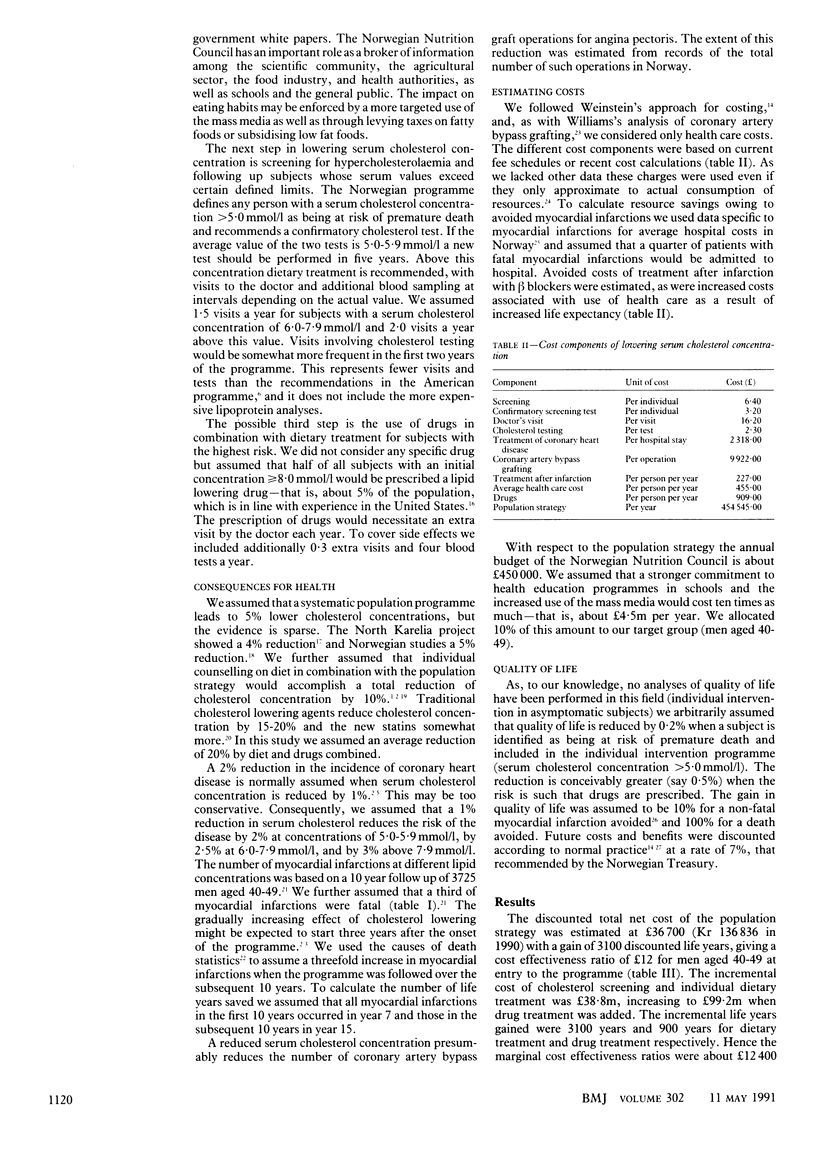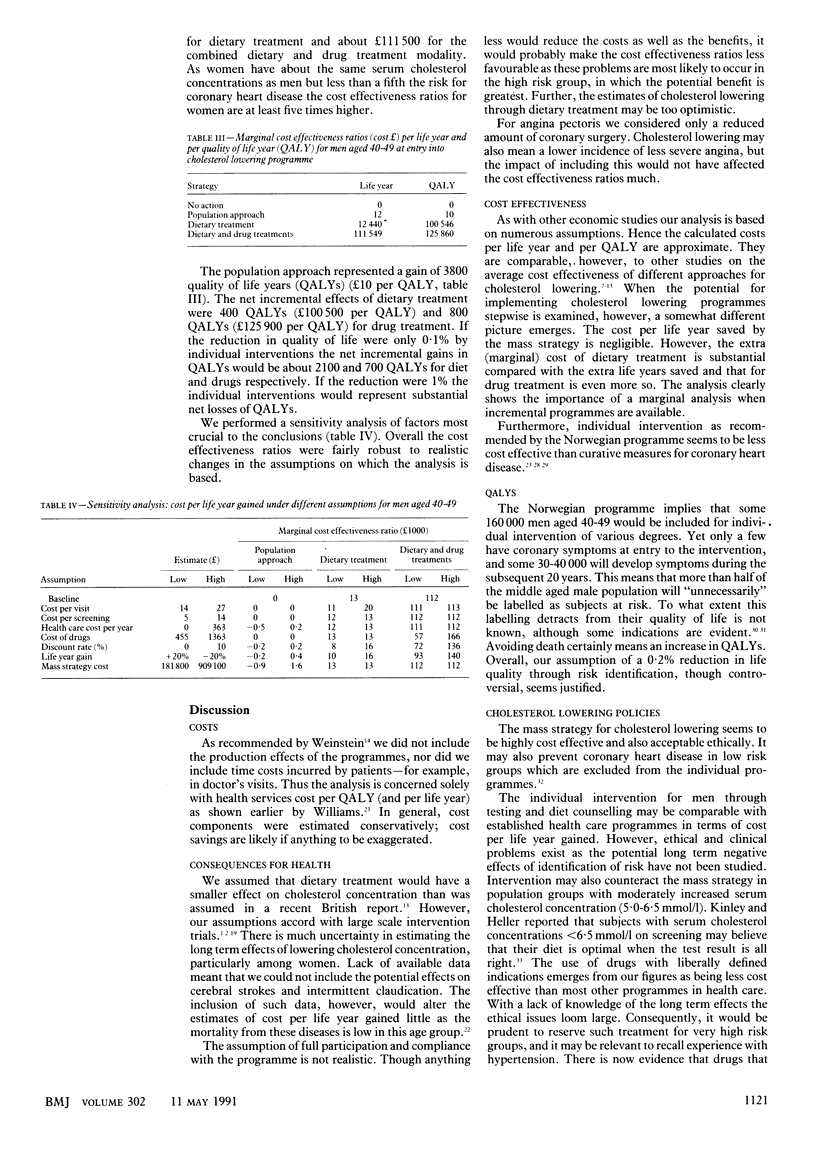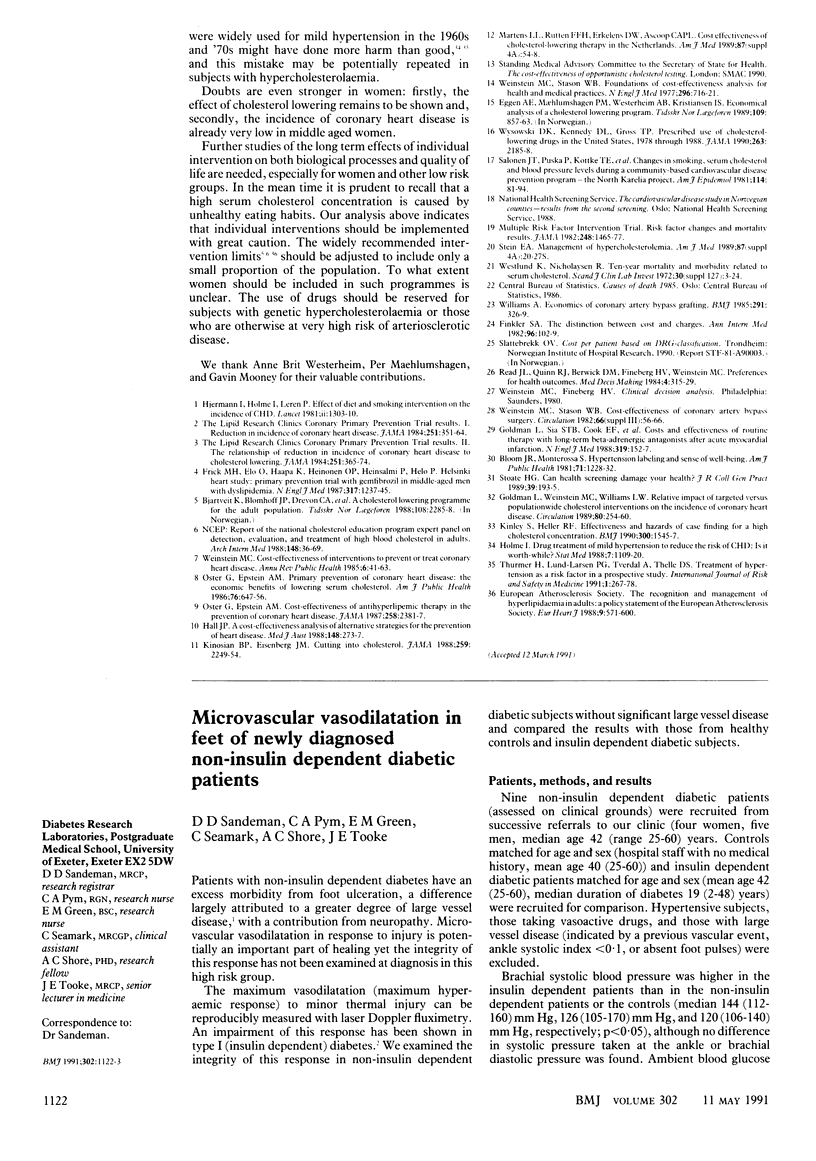Abstract
OBJECTIVE--To evaluate the relative cost effectiveness of various cholesterol lowering programmes. DESIGN--Retrospective analysis. SETTING--Norwegian cholesterol lowering programme in Norwegian male population aged 40-49 (n = 200,000), whose interventions comprise a population based promotion of healthier eating habits, dietary treatment (subjects with serum cholesterol concentration 6.0-7.9 mmol/l), and dietary and drug treatment combined (serum cholesterol concentration greater than or equal to 8.0 mmol/l). MAIN OUTCOME MEASURE--Marginal cost effectiveness ratios--that is, the ratio of net treatment costs (cost of treatment minus savings in treatment costs for coronary heart disease) to life years gained and to quality of life years (QALYs) saved. RESULTS--The cost per life year gained over 20 years of a population based strategy was projected to be 12 pounds. For an individual strategy based on dietary treatment the cost was about 12,400 pounds per life year gained and 111,600 pounds if drugs were added for 50% of the subjects with serum cholesterol concentrations greater than or equal to 8.0 mmol/l. CONCLUSIONS--The results underline the importance of marginal cost effectiveness analyses for incremental programmes of health care. The calculations of QALYs, though speculative, indicate that individual intervention should be implemented cautiously and within more selected groups than currently recommended. Drugs should be reserved for subjects with genetic hypercholesterolaemia or who are otherwise at very high risk of arteriosclerotic disease.
Full text
PDF



Selected References
These references are in PubMed. This may not be the complete list of references from this article.
- Bjartveit K., Blomhoff J. P., Drevon C. A., Gjone E., Hjermann I., Holm H. A., Kjekshus J., Levorsen A., Norum K. R., Nylenna M. Behandling av hyperkolesterolemi hos voksne. Handlingsprogram. Tidsskr Nor Laegeforen. 1988 Sep 30;108(27):2285–2288. [PubMed] [Google Scholar]
- Bloom J. R., Monterossa S. Hypertension labeling and sense of well-being. Am J Public Health. 1981 Nov;71(11):1228–1232. doi: 10.2105/ajph.71.11.1228. [DOI] [PMC free article] [PubMed] [Google Scholar]
- Eggen A. E., Maehlumshagen P. M., Westerheim A. B., Kristiansen I. S. Kostnad-effektivitetsanalyse av kolesterolsenkende tiltak. Okonomisk analyse av et handlingprogram. Tidsskr Nor Laegeforen. 1989 Mar 10;109(7-8):857–863. [PubMed] [Google Scholar]
- Frick M. H., Elo O., Haapa K., Heinonen O. P., Heinsalmi P., Helo P., Huttunen J. K., Kaitaniemi P., Koskinen P., Manninen V. Helsinki Heart Study: primary-prevention trial with gemfibrozil in middle-aged men with dyslipidemia. Safety of treatment, changes in risk factors, and incidence of coronary heart disease. N Engl J Med. 1987 Nov 12;317(20):1237–1245. doi: 10.1056/NEJM198711123172001. [DOI] [PubMed] [Google Scholar]
- Goldman L., Sia S. T., Cook E. F., Rutherford J. D., Weinstein M. C. Costs and effectiveness of routine therapy with long-term beta-adrenergic antagonists after acute myocardial infarction. N Engl J Med. 1988 Jul 21;319(3):152–157. doi: 10.1056/NEJM198807213190306. [DOI] [PubMed] [Google Scholar]
- Goldman L., Weinstein M. C., Williams L. W. Relative impact of targeted versus populationwide cholesterol interventions on the incidence of coronary heart disease. Projections of the Coronary Heart Disease Policy Model. Circulation. 1989 Aug;80(2):254–260. doi: 10.1161/01.cir.80.2.254. [DOI] [PubMed] [Google Scholar]
- Hjermann I., Velve Byre K., Holme I., Leren P. Effect of diet and smoking intervention on the incidence of coronary heart disease. Report from the Oslo Study Group of a randomised trial in healthy men. Lancet. 1981 Dec 12;2(8259):1303–1310. doi: 10.1016/s0140-6736(81)91338-6. [DOI] [PubMed] [Google Scholar]
- Holme I. Drug treatment of mild hypertension to reduce the risk of CHD: is it worth-while? Stat Med. 1988 Nov;7(11):1109–1120. doi: 10.1002/sim.4780071104. [DOI] [PubMed] [Google Scholar]
- Kinlay S., Heller R. F. Effectiveness and hazards of case finding for a high cholesterol concentration. BMJ. 1990 Jun 16;300(6739):1545–1547. doi: 10.1136/bmj.300.6739.1545. [DOI] [PMC free article] [PubMed] [Google Scholar]
- Kinosian B. P., Eisenberg J. M. Cutting into cholesterol. Cost-effective alternatives for treating hypercholesterolemia. JAMA. 1988 Apr 15;259(15):2249–2254. doi: 10.1001/jama.259.15.2249. [DOI] [PubMed] [Google Scholar]
- Oster G., Epstein A. M. Cost-effectiveness of antihyperlipemic therapy in the prevention of coronary heart disease. The case of cholestyramine. JAMA. 1987 Nov 6;258(17):2381–2387. [PubMed] [Google Scholar]
- Oster G., Epstein A. M. Primary prevention and coronary heart disease: the economic benefits of lowering serum cholesterol. Am J Public Health. 1986 Jun;76(6):647–656. doi: 10.2105/ajph.76.6.647. [DOI] [PMC free article] [PubMed] [Google Scholar]
- Read J. L., Quinn R. J., Berwick D. M., Fineberg H. V., Weinstein M. C. Preferences for health outcomes. Comparison of assessment methods. Med Decis Making. 1984;4(3):315–329. doi: 10.1177/0272989X8400400307. [DOI] [PubMed] [Google Scholar]
- Stoate H. G. Can health screening damage your health? J R Coll Gen Pract. 1989 May;39(322):193–195. [PMC free article] [PubMed] [Google Scholar]
- Weinstein M. C., Stason W. B. Cost-effectiveness of interventions to prevent or treat coronary heart disease. Annu Rev Public Health. 1985;6:41–63. doi: 10.1146/annurev.pu.06.050185.000353. [DOI] [PubMed] [Google Scholar]
- Weinstein M. C., Stason W. B. Foundations of cost-effectiveness analysis for health and medical practices. N Engl J Med. 1977 Mar 31;296(13):716–721. doi: 10.1056/NEJM197703312961304. [DOI] [PubMed] [Google Scholar]
- Wysowski D. K., Kennedy D. L., Gross T. P. Prescribed use of cholesterol-lowering drugs in the United States, 1978 through 1988. JAMA. 1990 Apr 25;263(16):2185–2188. [PubMed] [Google Scholar]


